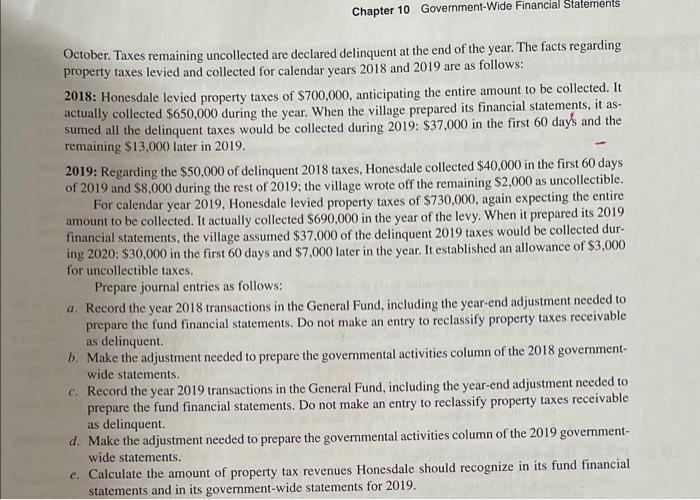R10-44. (Property tax revenue transactions and measurement in financial statements) Honesdale levies property taxes in March of each year to help finance the General Fund expenditures for the calendar year. Property owners are required to pay the taxes in equal installments in April and Chapter 10 Government-Wide Financial Statements October. Taxes remaining uncollected are declared delinquent at the end of the year. The facts regarding property taxes levied and collected for calendar years 2018 and 2019 are as follows: 2018: Honesdale levied property taxes of $700,000, anticipating the entire amount to be collected. It actually collected $650,000 during the year. When the village prepared its financial statements, it as- sumed all the delinquent taxes would be collected during 2019: $37,000 in the first 60 days and the remaining $13,000 later in 2019. 2019: Regarding the $50,000 of delinquent 2018 taxes, Honesdale collected $40,000 in the first 60 days of 2019 and $8,000 during the rest of 2019; the village wrote off the remaining $2,000 as uncollectible. For calendar year 2019. Honesdale levied property taxes of $730,000, again expecting the entire amount to be collected. It actually collected $690,000 in the year of the levy. When it prepared its 2019 financial statements, the village assumed $37.000 of the delinquent 2019 taxes would be collected dur- ing 2020: $30,000 in the first 60 days and $7,000 later in the year. It established an allowance of $3,000 for uncollectible taxes. Prepare journal entries as follows: a. Record the year 2018 transactions in the General Fund, including the year-end adjustment needed to prepare the fund financial statements. Do not make an entry to reclassify property taxes receivable as delinquent b. Make the adjustment needed to prepare the governmental activities column of the 2018 government- wide statements. c. Record the year 2019 transactions in the General Fund, including the year-end adjustment needed to prepare the fund financial statements. Do not make an entry to reclassify property taxes receivable as delinquent. d. Make the adjustment needed to prepare the governmental activities column of the 2019 government- wide statements. e. Calculate the amount of property tax revenues Honesdale should recognize in its fund financial statements and in its government-wide statements for 2019. R10-44. (Property tax revenue transactions and measurement in financial statements) Honesdale levies property taxes in March of each year to help finance the General Fund expenditures for the calendar year. Property owners are required to pay the taxes in equal installments in April and Chapter 10 Government-Wide Financial Statements October. Taxes remaining uncollected are declared delinquent at the end of the year. The facts regarding property taxes levied and collected for calendar years 2018 and 2019 are as follows: 2018: Honesdale levied property taxes of $700,000, anticipating the entire amount to be collected. It actually collected $650,000 during the year. When the village prepared its financial statements, it as- sumed all the delinquent taxes would be collected during 2019: $37,000 in the first 60 days and the remaining $13,000 later in 2019. 2019: Regarding the $50,000 of delinquent 2018 taxes, Honesdale collected $40,000 in the first 60 days of 2019 and $8,000 during the rest of 2019; the village wrote off the remaining $2,000 as uncollectible. For calendar year 2019. Honesdale levied property taxes of $730,000, again expecting the entire amount to be collected. It actually collected $690,000 in the year of the levy. When it prepared its 2019 financial statements, the village assumed $37.000 of the delinquent 2019 taxes would be collected dur- ing 2020: $30,000 in the first 60 days and $7,000 later in the year. It established an allowance of $3,000 for uncollectible taxes. Prepare journal entries as follows: a. Record the year 2018 transactions in the General Fund, including the year-end adjustment needed to prepare the fund financial statements. Do not make an entry to reclassify property taxes receivable as delinquent b. Make the adjustment needed to prepare the governmental activities column of the 2018 government- wide statements. c. Record the year 2019 transactions in the General Fund, including the year-end adjustment needed to prepare the fund financial statements. Do not make an entry to reclassify property taxes receivable as delinquent. d. Make the adjustment needed to prepare the governmental activities column of the 2019 government- wide statements. e. Calculate the amount of property tax revenues Honesdale should recognize in its fund financial statements and in its government-wide statements for 2019








